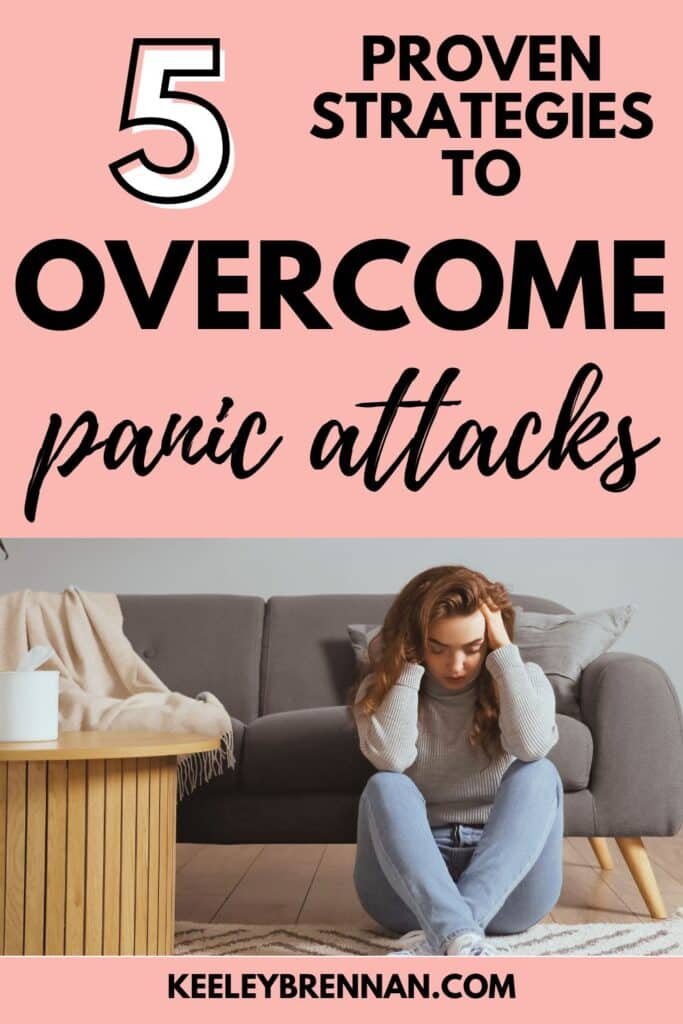Panic attacks can be terrifying.
And I’m guessing that if you’re reading this post, you’re looking for strategies to overcome panic attacks, prevent them from worsening, or them getting to the stage when you feel the world is ending.
So in this post, we’re going to kick off with some strategies for overcoming a panic attack, before diving into the reasons why we even have panic attacks in the first place.
How to Overcome a Panic Attack
Below are my 5 top strategies for overcoming a panic attack. I have and do use all of them, depending on where I am in a panic attack and where I am physically at the time of when I’m panicked.
You don’t need to try them all at once. In fact, I’d urge you not to. Trying too much is only going to add to your overwhelm.
Instead, try out different techniques to figure out what works for you and when.
My personal favourites and #1 and #2.
#1. Acknowledge What’s Happening
For me, acknowledging that what is happening is a panic attack is one of the most important things you can do to overcome a panic attack. It’s the idea that naming something somehow makes it less scary (and yes, I did just paraphrase Harry Potter there!).
By acknowledging that what you’re experiencing is a panic attack, you can remind yourself that what is happening is temporary.
Remind yourself that you are safe and that you aren’t going to die or come to any serious harm.
It’s horrid, it’s unpleasant, but it’s a panic attack. And it will pass.
#2. Focus On Your Breathing
In our post 16 Easy Self-Care Ideas to Do At Home: Free Ways to Look After Yourself, we talk about the Box Breathing technique.
Not only is Box Breathing a great self-care idea, it’s also a really good technique to use when you’re experiencing a panic attack.
Box Breathing is when you breath in and out, and hold your breath for 4 seconds per action. Simply put:
- Breath in for 4 seconds
- Hold your breath for 4 seconds
- Breath out for 4 seconds
- Hold your breath for 4 seconds
- Repeat
Box Breathing exercises can help to regulate your nervous system, so it’s a great exercise when you’re mid-panic attack and feel the need to recalibrate yourself.
You can also use Box Breathing when you feel a panic attack might be coming on. By regulating your nervous system when you feel you might start to have a panic attack, might help you avoid going into a full-blown one.
#3. Practice Grounding
Grounding is a really useful technique to help you realise that you are in a safe place and you aren’t in danger.
You can practice grounding in various ways, but a popular technique is the 5-4-3-2-1 method.
This is where you name 5 things you can see, 4 you can touch, 3 you can hear, 2 you can smell, and 1 you can taste. It doesn’t matter if you get these in a different order and name 5 things you can hear, 2 you can see, etc. The importance of this activity is that you are bringing yourself back to the present moment and helping your mind realise that you’re not in danger.
#4. Loosen Tight Clothing
A quickie, but a goodie.
When you’re in a panic attack, it can often feel like you can’t breathe. In reality, you can breathe very well – you’re actually overbreathing (hyperventilating).
Because you might feel like you can’t breathe (even though you can), loosening tight clothing can subconsciously make you feel more in control and help settle some of the panic that you can’t breathe.
#5. Try and Move Your Body
Commonly with panic attacks, you will pull yourself into your core (see the image at the start of this post).
This is a protective mechanism. But, during a panic attack your body is flooded with adrenaline. This is one of the main reasons why you end up with pins and needles and your muscles feeling like they’re on fire. Your body is getting ready to move (fight or flight).
Whilst you might want to stay scrunched up in your protective ball, your body will benefit from a little movement.
I’m not saying that you need to go out for a huge long walk. But even just stretching your arms, legs, and fingers out will not only help to distract your mind, but will also help loosen your muscles and start to move some of that adrenaline that has built up.

What are Panic Attacks?
Panic attacks are essentially your body’s way of dealing with anxiety or fear.
It’s your body’s way of preparing you with fight or flight, but the problem is that your body will often kick into this response when you don’t actually need to run away or fight anyone.
When you experience a panic attack, your body floods itself with adrenaline. And it’s this response that gives us the unpleasant symptoms of a racing heatbeat, shortness of breath, etc.
Even though this burst of anxiety or fear can feel like it’s lasting for hours, panic attacks often only last for a few minutes (although they can last up to half an hour).
Why Panic Attacks Happen
What triggers a panic attack for you will depend on what you’ve experienced in the past, but can happen for a range of reasons, including:
- Stress
- Being in a crowded place
- Being bullied/talked down to
- Feeling overwhelmed with work
In the context of violence against women and girls (VAWG), panic attacks will often happen because you’ve been triggered by the abuse that you have experienced in the past.
For example, you:
- See the perpetrator out in public
- See something on the tv or news that reminds you of what you experienced
- Hear the perpetrator’s name
- Have a flashback about the abuse you experienced
What do Panic Attacks Look and Feel Like?
How you experience a panic attack will depend on you as a person. For me, panic attacks are about experiencing shortness of breath, feeling disorientated, racing heartbeat and tingling fingers and hands.
According to the NHS, common symptoms of panic attacks can include:
- What feels like an irregular or racing heartbeat (palpitations)
- Sweating
- Trembling
- Shortness of breath (hyperventilation)
- A choking sensation
- Nausea
- Dizziness
- Tingling fingers
- Ringing in your ears
- Feeling disorientated
- Dry mouth
It’s a lot. Especially when you consider that panic attacks can last (on average) anywhere between 5 and 30 minutes.

Are Panic Attacks Dangerous?
I won’t sugar coat it; panic attacks can feel terrifying. Extreme ones feel like you can’t breath and like you’re about to die.
I promise you, though, panic attacks aren’t dangerous.
Panic attacks are actually the body’s way of responding to danger. Back in the days when we were fighting sabre-tooth tigers and living in caves, a panic attack would be beneficial by giving us a surge of adrenaline that would either help us to fight whatever the danger was, or to run away as fast as we could.
It’s the original fight or flight response.
In today’s world, though, we don’t need exactly the same responses to danger. So whilst you might feel that your body can’t cope with a panic attack; it can, and it will.
And I get that emotionally panic attacks are rough as hell.
They are exhausting to not only experience, but also to come down from afterwards as well.
Managing panic attacks is something that you can learn. Try out the different techniques we listed above and see what works for you.
And remember, if you’re in immediate danger, or have suicidal thoughts, don’t be afraid to contact the emergency services for proper support. You can check out our list of Support Services, with contact details, by clicking here.
Final Thoughts
Panic attacks can be scary as hell. And just because you’ve dealt with one successfully, does not mean that you’ll never have one again.
But by utilising the strategies in this post for coping with panic attacks will help you identify coping strategies that work best for you.
Remember, you didn’t deserve to experience what happened to you. And you don’t deserve to be experiencing unwelcome panic attacks now.
But you do deserve to feel in control of these symptoms when they rear their ugly head.
Trust yourself; you’ve got this. You’re more in control than you think.
Pin for Later




